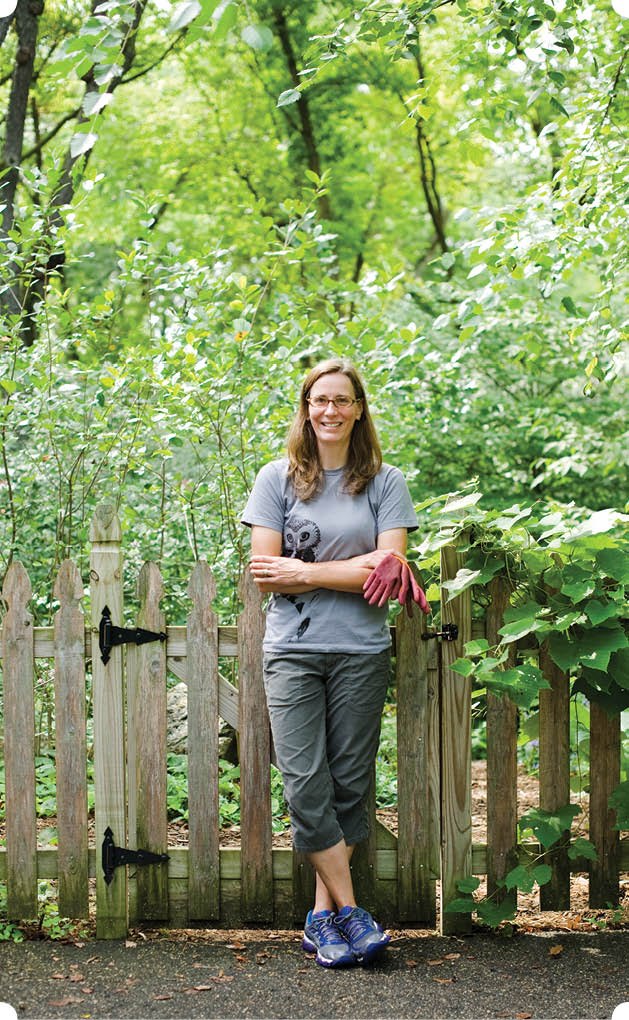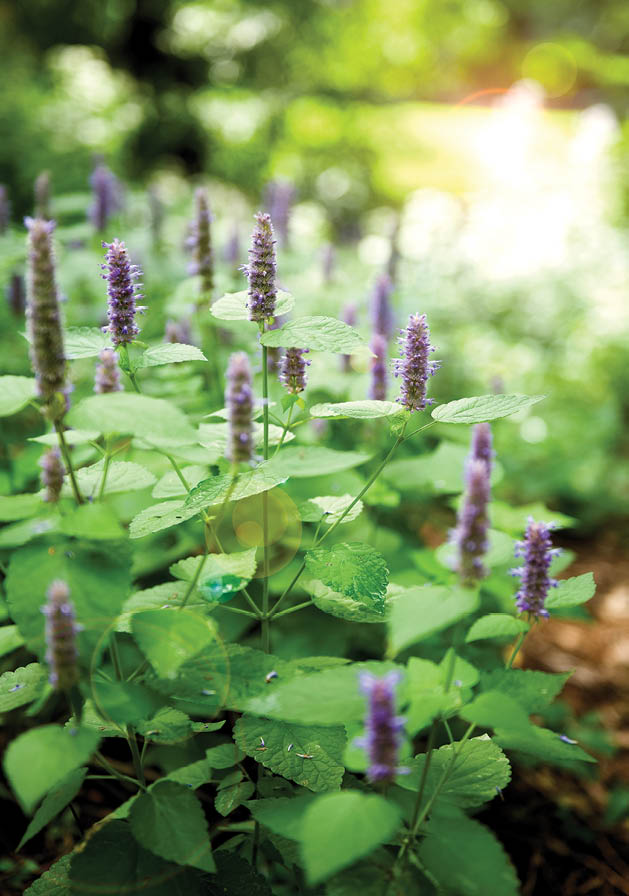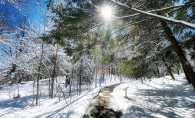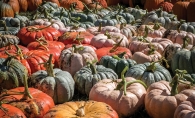Glance up Heather and Brent Holm’s driveway, and you will spot three signs on the front wooden gate: “Monarch Way Station,” “Wild Ones: Native Plants, Natural Landscapes,” and an award for a first-place restoration project. All three signs describe what visitors find beyond the friendly entrance.
The Holms’ garden is an oasis for pollinators, the insects and animals that carry pollen from flower to flower or plant to plant. Heather Holm, the author of Pollinators of Native Plants: Attract, Observe and Identify Pollinators and Beneficial Insects with Native Plants, says bee-friendly is the way to go; she won’t plant any other way, because she believes it’s an overall better way to plant. Her garden is also a breeding ground for native Minnesota plant life and hosts an economically friendly watering system.
The Holms’ Minnetonka garden wasn’t always so environmentally astute. When the couple moved into their home 10 years ago, the front yard was mostly paved. “We wanted to turn it back into something that was here before that,” Heather Holm says.
It took 40 dump trucks to get rid of the paving and fill, and now, green shrubbery has replaced pavement. Holm dubbed her driveway garden the “rain garden” and for good reason: It houses only plants that like “wet feet,” or thrive in a wet environment. But this oasis is only the beginning of the Holms’ impressive landscape.
Horticulture Roots
Growing up, Holm spent many afternoons in her grandfather’s vegetable garden. “I was always interested in the outdoors,” she says, so studying horticulture and biology in college seemed fitting. Post-graduation, she worked for numerous greenhouses and growing operations, but eventually returned to school to study graphic and web design (the field in which she still works
at Holm Design & Consulting). When Holm began planting native plants at a previous home more than 15 years ago, she says the light bulb came on. She started studying and researching on her own time and decided that her gardens from there on out would feature native plants, and native plants only.
She and Brent moved to Minnesota in 2004 to be closer to his family, and she says their home, situated on a woodsy, isolated cul-de-sac in front of a pond, was ideal. “We liked the number of mature trees, and the size and the age of the trees with a smaller house,” Holm says. “To me, it was a great template for fixing.”
And fix she did. The renovation began shortly after the couple moved in. The yard was divided into zones. “The approach was to come up with three zones to plant the most different types of plants,” she says.
Join us on a journey through the Holms’ garden maze, which begins at that sign-laden wooden gate, just after you pass an objet d’art, a rusted metal crane.
Zone 1: Moist Woodland
Once through the gate, take a sharp right, where you will find a peculiar tree with horizontal branching, and several species of woodland wildflowers—wild geranium, Jacob’s ladder and wild columbine, to name a few. Holm deems this her “nice showy things” spot. Although it may seem a bit overgrown and haphazard to the eye, with flowers and shrubs strewn about, it’s just the way she likes it.
“Part of the experiment of my yard is I have let it evolve,” she says. “Plants will seed out of this organized matter and become more naturally unorganized.” These “unorganized” plants tally up to 200 different shrubs, trees and perennials throughout the entire yard. All are natives, meaning they exist naturally in Minnesota conditions without human interaction.
Friend Marilynn Torkelson, who took Holm’s advice and began planting native plants, says her idea of beauty has shifted since letting her garden grow more naturally. “Your idea of beauty evolves,” says Torkelson. “You are taking into account the environment, insects and birds. You help nurture it along.”
Zone 2: Dry Prairie
On the other side of a stone bench and tree brambles, just to the left of the gate and Zone 1, the yard steeply inclines and you might stumble across a set of logs. These are not just makeshift stairs; in the Holms’ yard, every flower, tree, twig and shrub has a purpose. Rarely is any organic material hauled out.
Holm says Zone 2 receives the most sunlight and is a haven for pollinators. She will often find butterflies and bees fluttering from one stem to the next. To ensure a pollinator-populated garden, it is most important to have more than one plant flowering at one time and to not always go for the brightest colors, Holm says. She planned for this in Zone 2 by planting flowers with dull colors, flat petals—think black-eyed Susan—and deep roots.
While we might not think of dullness as what gives a garden its oomph, says Torkelson, “you learn to be charmed by the smaller flower and the subtle beauty.”
Zone 3: Dry Woodland
Once you creep past the left side of the house, through yellows, greens and reds, the Holms’ backyard awaits. Where now woodland phlox, dogwoods and spruce grow, there were once bushels of creeping Charlie and buckthorn, a sight that Holm calls “not pretty.”
Now, the majority of the back yard is all grass—prairie grass, that is. Along with its visual appeal, another perk of the prairie-filled backyard is its low maintenance. Holm says they only mow their lawn about six times each year. “I am spending more time just hanging out in the yard than working on it,” she says. “That, to me, is priceless.”
Environmentally Friendly
In this garden, you won’t find a single spigot or sprinkler. Instead, to the left of the house there are six large barrels; the tanks collect two-thirds of the rainwater that falls from the roof, which Heather and Brent use to water the lawn.
Similarly, Holm doesn’t use any pesticides, fertilizers or chemicals in her gardening. She also removes invasive species in the area to ensure that the native plants can thrive and flourish.
Both birds and insects (and friends) tend to migrate toward native plants: warblers, sparrows and chickadees are often found among the flora. Says friend Ruth Peterson, “[Heather’s] garden always looks beautiful to me, welcoming and inviting. I know it is to wildlife as well.”
What’s the most rewarding part of all this toil in the soil? “The garden becomes not about you,” says Holm. “I think that’s where the light goes on, too. You are doing these things for not only wildlife, but perhaps making the landscape healthier for the next generation.”
Eco-Friendly Sprucing:
Interested in crossing over to a pollinator-friendly garden with native plants and species, but unsure how to begin? According to Heather Holm, it’s simple.
1.Research
Holm advises getting a good grasp on the sun exposure and soil quality in your yard. After all, these two variables most dictate what sort of plants will thrive. She says to take cues from the nature around you and visit a park that resembles your yard conditions. “Find the right plant that is matching the exact conditions where it goes naturally in your yard. That’s the recipe for success.”
2.Start small
If you’re a gardener who loves exotics, fear not. You don’t have to make the transition fully or immediately. “Start mixing in natives where exotics didn’t grow. You don’t have to have a 100 percent native yard to support wildlife and diversity. It can be a mix.”
3.Utilize grants
The local watershed gives grants to homeowners to install a rain garden or restore native shoreline or plantings. It gives top priority to those who are looking to improve their habitat and decrease erosion. To date, Holm has received three grants to further her gardening endeavors.
4.Get Involved
Marilynn Torkelson says Wild Ones, a nonprofit that seeks to inform about native plants and sustainable landscaping, is always looking for new members (Torkelson is the president and Holm is the vice president of the Prairie Edge chapter). Meet with fellow gardeners for tips and advice. Visit prairieedge.wildones.org for more information. Holm also suggests trying a rain garden class, which can be found at several organizations throughout the Twin Cities. Try Metro Blooms at metroblooms.org.


Pollinators of Native Plants:
Holm self-published Pollinators of Native Plants: Attract, Observe and Identify Pollinators and Beneficial Insects with Native Plants in 2014 after she was unable to find other books on the topic. It focuses on native plants and maintaining a pollinator-friendly garden. She says she wrote it for everyone, from those who take on prairie restorations as a career to first-time gardeners. “I was aiming for a wide audience and to fill that information gap,” she says.
Pollinators of Native Plants is available at several area locations, including the Minnesota Landscape Arboretum, and online from Amazon or Barnes & Noble. For more information, visit restoringthelandscape.com.
Another perk of the prairie-filled backyard is its low maintenance. Holm says the best native gardens are the ones you let evolve on their own.









